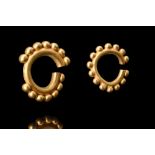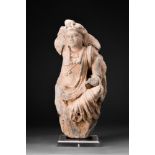Filtered by:
- Category
- List
- Grid
A subscription to the Price Guide is required to view results for auctions ten days or older. Click here for more information
OTTOMAN PAIR OF GOLD EARRINGS
Ca. late 19th century AD. A pair of gold earrings with graceful curves of the hooks and loops draw the eye down to the teardrop-shaped pendants, w...
ISLAMIC STONE AND SILVER PENDANT
Ca. 17th-19th century AD. A rectangular-shaped pendant with a carved stone at the center stage, elevated in a silver frame with two suspension loo...
Ca. 1100-1200 AD. A gold ring of tapering profile, crafted with the utmost skill and attention to detail. The ring's shoulders are richly adorned ...
Ca. 1200 AD. A gold ring of flat section hoop, expanding gracefully at the shoulders, is embellished with intricate incised designs that reflect t...
ISLAMIC DECORATED BRASS TRAY
Ca. 17th-19th century AD. A circular tray, crafted from brass with a flat base, intricately chiseled sides and enchanting engraving on its interio...
ISLAMIC STEMMED DISH
Ca. 17th-19th century AD. A stemmed dish with a nicely formed bowl that boasts a shallow, wide basin. The dish sits atop a splayed foot, adding an...
Ca. 400 -500 AD. A jasper intaglio engraved with a scene depicting two figures, facing each other and flanking a fire altar. They are making offer...
Ca. 500 - 600 AD. A rare gold ring featuring an exquisite intaglio of a Sasanian horserider seated with ease atop his mount, his face finely detai...
SELJUK GOLD RING
Ca. 1100-1200 AD. A gold ring with stunning gemstone is a remarkable example of the exquisite craftsmanship and opulence of Seljuk gold jewellery....
PARTHIAN GOLD PAIR OF EARRINGS
Ca. 2nd century AD. A pair of matched earrings, cast in gold. Each earring comprises a delicately crafted hoop that gracefully dangles from the ea...
PARTHIAN GOLD PAIR OF EARRINGS
Ca. 2nd century AD. A matched pair of gold earrings. These earrings are a breathtaking sight, with each hoop meticulously attached to a drop-shape...
PARTHIAN GOLD PAIR OF EARRINGS
Ca. 2nd century AD. A pair of matched earrings made of gold. Each earring boasts a hoop, attached to a four-compartmented plaque adorned with an e...
Ca. 1200 BC. A remarkable fibula brooch, a true masterpiece of ancient metalwork. This exquisite piece is crafted from intricately wound and arran...
BRONZE AGE GOLD EARRINGS
1st millenium BC . A matched pair of gold earrings. At the heart of each earring is a round hoop, expertly crafted from the finest gold. The gold ...
Ca. 200-300 AD. A schist-carved sculpture of a bodhisattva, possibly Padmapani, depicted in a serene seated position. The graceful folds of his sa...
Ca. 200-300 AD. A gold Legionary finger ring of a D-shaped hoop with a rounded exterior edge and a flat interior, which is set with the stunning i...
Ca. 4th century BC. An enchanting pair of gold earrings, a testament to the ingenuity and creativity of ancient goldsmiths. Each earring is a mast...
Ca. 664-30 BC. A selection of five uzat amulets, also referred to as eye of Horus or Wedjat-eye amulets, with fine details and notched eyebrows. T...
Late Period, ca. 664-332 BC. An amulet formed in the shape of a papyrus column known as a papyrus sceptre or Wadj sceptre. This delicately formed ...
Ca. 1938-1292 BC. A fine Egyptian steatite scarab with naturalistic features such as a clypeus and prothorax marked by incised lines. The reverse ...
Ca. 1070-664 BC. An interesting glazed steatite scarab with incised detail to the top to form naturalistic features of a scarab beetle. On the fla...
EGYPTIAN FAIENCE THOTH AS BABOON
Ca. 664-332 BC. A green, glazed faience composition amulet of Thoth represented as a naturalistic baboon, the god of the moon. Thoth is depicted w...
EGYPTIAN CARNELIAN SCARAB
Ca. 664-332 BC. An Egyptian carnelian scarab with incised detailing to form a ridged carapace and naturalistic features. The flat underside has be...
EGYPTIAN STEATITE SCARAB
Ca. 1550-1070 BC. A steatite Egyptian scarab with incised features such as the clypeus, prothorax, and elytra marked by single lines. The scarab i...
Late Period, ca. 664-332 BC. A funerary shroud, meticulously composed of faience beads arranged in a distinctive net pattern. The shroud's captiva...
Ca. 664-30 BC. A collective group of five eye of Horus amulets, also called wedjat eyes, with fine details, notched eyebrows. The amulet is horizo...
Ca. 1550-664 BC. A fine Egyptian steatite scarab with naturalistic features such as a clypeus and prothorax marked by incised lines. The reverse i...
Ca. 1550 BC. A fine cream-coloured steatite scarab with naturalist features, the reverse depicted a walking lion in a motion of roaring. The mouth...
EGYYPTIAN STEATITE SCARAB
Ca. 1938-1292 BC. A fine steatite scarab with naturalistic features including clypeus and prothorax marked by incised lines. The reverse is detail...
EGYPTIAN STEATITE SCARAB
Ca. 1938-1292 BC. Scarab carved from light green glazed steatite decorated with naturalistic features including clypeus and prothorax. The undersi...
Ca. 664-332 BC. A green faience glazed amulet of Horus in the shape of a falcon. The deity is depicted standing on an integral trapezoidal base, f...
Ca. 332-30 BC. A fine pale turquoise glazed faience amulet in the form of a recumbent lion, on an integrated base, the front paws outstretched, th...
Late Period, ca. 664-332 BC. A captivating funerary shroud, crafted with meticulous precision and adorned with a distinctive net pattern composed ...
Ca. 664-30 BC. A group of well-defined wedjat eyes, with fine details, notched eyebrows. The amulet is horizontally pierced for suspension. The we...
Ca. 1390-1352 BC. Egyptian white steatite scarab with inscribed hieroglyphs to the reverse, detailing a seated goddess holding the 'ankh' symbol f...
Ca. 1550-1070 BC. An extremely fine example of an amulet in the shape of a scarab with features naturalistic to those of a dung beetle. The revers...
EGYPTIAN GLAZED STEATITE SCARAB
Ca. 1070-664 BC. A bright blue steatite scarab with naturalistic features including clypeus and prothorax. The flat underside is unclear but possi...
Ca. 664-332 BC. This extremely fine modelled amulet depicts a scarab with a naturalistic underside and a loop and its belly. Scarabs in this shape...
Ca. 332-30 BC. A fine pale turquoise glazed faience amulet in the form of a recumbent lion, on an integrated base, the front paws outstretched, th...
Ca. 1550-1070 BC. A delicate and finely detailed turquoise glazed steatite scarab inscribed to the reverse. The front of the scarab includes fine ...
EGYPTIAN STEATITE SCARAB
Second Intermediate Period, ca. 1720-1650 BC. A steatite scarab seal with its clypeus, prothorax, and elytra delicately detailed and engraved to t...
EGYPTIAN STEATITE SCARAB
Hyksos Period of the 15th Dynasty, ca. 1650-1550 BC. A steatite scarab seal with cyleus, prothorax, and elytra carved with great detail and care. ...
Ca. 1069-332 BC. A finely detailed ancient Egyptian blue faience udjat eye or wedjat eye amulet, more commonly referred to as the Eye of Horus. Th...
EGYPTIAN ROCK CRYSTAL SCARAB
Ca. 1550-1070 BC. A nice example of a rock crystal scarab amulet in the form of a scarab with naturalistic detailing the clypeus, prothorax, and e...
Ca. 664-332 BC. A steatite Egyptian scarab with incised features and hieroglyphs to the reverse. The front anatomy features a detailed head and cl...
Ca. 7th-6th century BC. A gold ring made of gleaming gold, expertly crafted into a D-shaped shank that fits snugly and comfortably around the fing...
Ca. 4th century BC. A breathtaking example of the intricate artistry and mastery of ancient goldsmiths. Each earring boasts a hook adorned with a ...
Ca. 4th century BC. A gold chain, a masterpiece of ancient goldsmithing. With its loop-in-loop form and intricate filigree work, this chain is a t...
Ca. 4th century BC. A matching pair of gold earrings exuding beauty and elegance. The delicate filigree design, coupled with the spherical baubles...
Ca. 4th century BC. A restrung necklace composed of barrel-shaped beads, showcasing a stunning array of translucent and opaque hues, ranging from ...
Phoenician, ca. 600 BC and later (up to post medieval). A captivating restrung necklace, adorned with intricate mosaic glass eye beads. This exqui...
Ca. 6th-4th century BC. A silver fibula, featuring a double-arched bow with central ropework decoration, protruding knobs, and a prominent catch-p...
Ca. 100-300 AD. An amethyst intaglio depicting a hedgehog, a creature that has long fascinated humans with its spiny exterior and unique appearanc...
Ca. 100 BC - 100 AD - Late Republican. A gold finger ring, Hening type I, of unparalleled beauty and sophistication. Its round hoop expands to for...
Ca. 100-300 AD. A finely engraved intaglio set in a gold ring with widening shoulders. On the left side of the intaglio, we see a male figure stan...
Ca. 300 AD. A gold finger ring with its band formed into a hoop with duck-head finials, which adds a unique touch to the design. The bezel cell is...
Ca. 100-300 AD. A carnelian intaglio set in a possibly later gold ring capturing a poignant scene of mourning, likely depicting Aristomenes, sitti...
Ca. 200-300 AD. A gold finger ring with a carnelian portrait intaglio is a stunning example of the intricate artistry and skill of Roman gem engra...
Ca. 100-300 AD. A chalcedony cameo, with its finely carved features and lifelike detail, depicts the infamous Gorgon with her characteristic serpe...
Ca. 200 - 300 AD. A gold finger ring with a carnelian portrait intaglio features one of the most important gods in the Roman pantheon, Jupiter. In...





























































